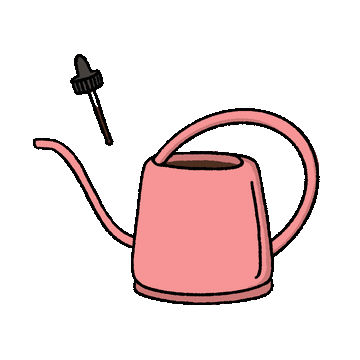Taking care of houseplants during winter can feel like a challenge. With shorter days, cooler temperatures, and lower humidity, your indoor garden might seem less vibrant. But don’t worry—with the right care, your green sanctuary can thrive even in the chilliest months.
This guide covers ten essential tips for nurturing your plants during winter. Whether you're a seasoned plant parent or just starting out, these actionable insights will make winter care a breeze.
Adjust Watering Frequency
"Winter means less light, and generally speaking, less light means less water," says Erin Marino from The Sill. In winter, most plants slow down their growth due to reduced sunlight, which means they don’t need as much water as they do in the warmer months. A weekly watering schedule from summer might now stretch to every two weeks, but this can vary depending on the type of plant and its environment.
The smartest move? Check the soil before watering. Stick your finger about an inch into the soil—if it feels dry, it’s time to water. If it still feels damp, hold off for a few more days. For those who prefer a hands-off approach, invest in a moisture meter to take the guesswork out of hydration. These handy devices give precise readings, letting you know exactly when your plant is thirsty. Remember, it’s always easier to add water than to deal with the consequences of overwatering.
Avoid Overwatering
Overwatering is a major plant killer, especially during winter. With reduced sunlight and cooler temperatures, water takes longer to evaporate from the soil, leaving plants more vulnerable to waterlogged roots. Overwatering often leads to root rot, a condition that can be challenging to fix and may result in losing your plant altogether.
If you’re someone who tends to overwater, consider using a watering can with a narrow spout so you can pour with control and precision. It’s also a good idea to use pots with drainage holes that allow excess water to escape, preventing it from sitting at the bottom and soaking the roots for too long. Pro tip: Always discard any water that collects in the saucer after watering to avoid root damage.
Let Plants Acclimate
If you’ve moved your indoor plants from a sunny window to a dimmer spot or relocated outdoor plants indoors for the winter, expect them to take some time to adjust. Changes in light and temperature can be stressful for plants, and during this period, you might notice leaf loss or slowed growth. Don’t panic—this is normal. It’s your plant’s way of adapting to its new environment.
During this acclimation phase, resist the urge to fertilize or repot your plant, as either action can add unnecessary stress. Instead, focus on giving it stable conditions and time to settle into its new home. Be patient—your plant will thank you.
Expect Leaf Drop
Speaking of adjustments, it’s common for plants to drop a few leaves during the winter months. This is especially true for plants that have been moved indoors or to an area with lower light. Leaf drop is a natural response to the seasonal change and doesn’t necessarily mean your plant is unhealthy.
Rather than worrying, focus on keeping the remaining leaves in good health. Dust leaves regularly to help them absorb as much light as possible, and rotate the plant occasionally to ensure even exposure to sunlight. Providing proper care during this season will keep your plant strong and ready for new growth come spring.
Protect Against Drafts
Hot and cold drafts can wreak havoc on plants by causing sudden temperature changes, which can stress and damage them. Whether it’s a blast of hot air from a heater or a cold breeze from an open window, these temperature shifts are far from ideal for your greenery.
To protect your plants, keep them away from radiators, heating vents, or doors that frequently open to the cold. If your plant is near a drafty window, consider hanging a thick curtain to block the breeze or moving the plant to a more stable spot. Consistent temperatures are key to keeping plants happy and healthy throughout the winter.
Reduce Fertiliser
Most houseplants slow or stop their growth during winter as part of their natural cycle, meaning they don’t need as many nutrients. Fertilising at this time can lead to nutrient buildup in the soil, which may harm your plant instead of helping it.
The best approach is to pause fertilising in late autumn and resume in spring when growth picks up again. If you feel your plant needs a boost, opt for an organic fertiliser, such as The Plant Runner's indoor plant food. Organic fertilizers release nutrients slowly, ensuring your plant absorbs only what it needs without overloading the soil.
Watch for Pests
While winter might seem like a pest-free season, the warm, dry air inside your home can create a perfect breeding ground for bugs like spider mites, aphids, and scale. These pests often hide on the undersides of leaves or along stems, making them easy to miss until they’ve spread.
To prevent infestations, inspect your plants regularly. Look closely at leaves and stems for signs of pests like webbing, tiny specks, or sticky residue. If you spot any, treat the affected areas with a registered neem oil or insecticidal soap to stop the problem early. Products like The Plant Runner Neem Oil Leaf Shine are not registered with the APVMA and we cannot promote it as a pesticide. Neem oil will not only manage pests but also keep your plant’s leaves glossy and vibrant.
Don't Mist
It’s a common misconception that misting plants increases humidity. In reality, the small amount of moisture from misting evaporates quickly and doesn’t significantly impact your plant’s environment.
If you want to create a more humid space, try grouping plants together, using a humidifier, or placing your plants on a tray filled with water and pebbles. These methods offer a more stable and effective way to boost humidity, particularly for tropical plants that thrive in moist environments.
Resist Repotting
Winter is not the time to repot your plants. Because most plants enter a dormancy period during colder months, repotting at this time can shock them, leading to stress and potential growth setbacks.
Instead, save repotting for spring or early summer when plants are actively growing and better able to handle the transition. In the meantime, focus on planning ahead—take note of which plants may need a larger pot or fresh soil when the growing season returns.
Consider Plant Accessories
Make winter plant care easier with the right accessories. Stylish plant stands can elevate pots closer to natural light, while self-watering pots make keeping your plants hydrated a breeze. Neem oil, like The Plant Runner's Neem Oil Leaf Shine, can prevent pests and keep foliage looking its best throughout the season.
And don’t forget to treat yourself too! Bundles like The Plant Runner Essentials Bundle or Booster Bundle are a great way to upgrade your plant care routine and ensure your greenery stays vibrant all year long. Winter plant care doesn’t have to be complicated—just a little extra attention goes a long way in keeping your plants happy and healthy
Keep Your Winter Garden Thriving
Winter plant care doesn’t need to feel overwhelming. By making small adjustments to watering, light exposure, and overall maintenance, your plants can thrive through the coldest months.
Remember, every plant has its own preferences. Observe your greenery closely and tailor its care accordingly. And if you’re ready to step up your plant parent skills, browse The Plant Runner's range of care products to keep your leafy friends lush and happy all year round.



Leave a comment